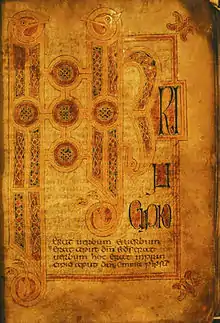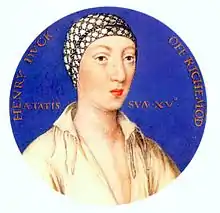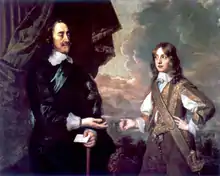Royal bastard
A royal bastard was a common term (now largely dropped from common usage) for the illegitimate child of a reigning monarch. These children were considered to be born outside of marriage - either because the monarch had an extra-marital affair, or because the legitimacy of the monarch's marriage had been called into question.
.svg.png.webp)
| Part of a series of articles on |
| Monarchy |
|---|
.svg.png.webp) |
| Politics portal |
Notable royal bastards include Henry FitzRoy, son of King Henry VIII of England, and the Duke of Monmouth, son of Charles II. The Anglo-Norman surname Fitzroy means son of a king and was used by various illegitimate royal offspring, and by others who claimed to be such. In medieval England a bastard's coat of arms was marked with a bend/baton sinister.[1]
Notable fictional instances include the legendary character Mordred, who was often portrayed as King Arthur's villainous illegitimate son. Some fictional portrayals of royal bastards were less negative, such the character of Philip the Bastard (also known as of Cognac) in Shakespeare's King John.
Ancient Rome
Unlike medieval royalty, the Romans were more concerned with continuity of family name than with bloodline.[2] If a man recognized a child as his, this was accepted by law, and the issue of who the biological father was did not arise.[2] If a child was not recognized, he or she could be exposed or brought up as a slave. For example, Emperor Claudius initially accepted a girl as his daughter, but later rejected her and had her exposed.[2] Emperors often adopted their successors. There are no recorded examples of aristocrats in classical times accusing other aristocrats of being illegitimate, as was common in later periods.[2]
Caesarion was possibly the illegitimate son of Julius Caesar by Cleopatra, which would also make him Caesar's only known child besides Julia.
Belgium
A book published in February 2011 claimed that Albert II of Belgium has an illegitimate half-sister named Ingeborg Verdun, the daughter of King Leopold III and Austrian-Belgian ice skater Liselotte Landbeck.[3]
In October 2020, the bastard daughter of Albert II of Belgium was legally acknowledged after DNA testing to be titled Princess Delphine of Belgium by the Belgian Court of Appeal. Ms Delphine Boël intends to change her surname to her father's Saxe-Coburg.[4]
Flanders and Brabant
Older illegitimate children founded important family branches, as reported in the Trophées de Brabant: tome 1[5]([6]):
- House of Witthem, legitimised son of John II, Duke of Brabant.
- House of Brant, legitimised son of John III, Duke of Brabant.
- House of Glymes, legitimised son of John II, Duke of Brabant.
- House of Nassau-Corroy, legitimised son of Henry III of Nassau-Breda
- House of Dongelberghe, legitimised son of John I, Duke of Brabant.
- House of Mechelen, legitimised son of John I, Duke of Brabant.
England, Scotland, Great Britain and the United Kingdom
English kings


Papal legates decree in 786
In the Anglo-Saxon Heptarchy then Kingdom, descendants of kings were called aethelings, whether legitimate or not. When a kingship became vacant, a Witan would meet to name an aetheling as king. Papal legates visited the great hall of Offa of Mercia in 786 and decreed that an English king "must not be begotten in adultery or incest" and that "he who was not born of a legitimate marriage" could not succeed to the throne.[7] It is likely no rule of succession had set as to bastardy before this decree.[7]
Edward the Elder
Athelstan, his acknowledged illegitimate son, succeeded as king in 924.
Duke of Normandy
William the Conqueror was an acknowledged illegitimate son of a line of three Norman dukes noted for many truces; he was of Scandinavian, Breton, Anglo-Saxon and North French royal and noble descent.
Stephen
Gervase de Blois (written variously, often in latest books Gervais of Blois), a bastard of Stephen I, was Abbot of Westminster from 1138 to c. 1157.[8]
Henry I
Henry I had 21 to 25 illegitimate children, including Robert, 1st Earl of Gloucester, Sybilla of Normandy (wife of King Alexander I of Scotland) Maud FitzRoy (wife of Conan III, Duke of Brittany), Constance or Maud FitzRoy, Mabel FitzRoy, Alice FitzRoy, Gilbert FitzRoy, and Emma.[9] "It might be permissible to wonder how it was that Henry I managed to keep track of all his illegitimate children, but there is no doubt that he did so," wrote historian Given-Wilson.[8]
Henry II
Henry II had several bastards, most notably Geoffrey, Archbishop of York and William Longespée, 3rd Earl of Salisbury (who inherited his earldom from his wife's father, William of Salisbury). William's mother was Ida de Tosny, while Geoffrey's may have been called Ykenai.
Richard I
Richard the Lionheart had at least one illegitimate child: Philip of Cognac, who died young (possibly in battle). He features as Philip the Bastard in Shakespeare's King John.
John
John had at least five children with mistresses during his first marriage to Isabelle of Gloucester, and two of which are known to have been noblewomen. He had eight or more others including Jeanne/Joan, Lady of Wales (wife of Llywelyn the Great) and Richard FitzRoy.
Edward IV of England
Edward IV had at least five illegitimate children, including Arthur Plantagenet, 1st Viscount Lisle (later Lord Deputy of Calais) by his mistress Elizabeth Lucy.
Perkin Warbeck closely resembled Edward IV and claimed to be his son Richard of Shrewsbury; it has been theorised that Perkin was one of Edward's illegitimate children.
Richard III justified his accession to the throne by claiming that the children of Edward IV were the product of an invalid marriage.
Richard III
Richard III had at least two illegitimate children: John of Gloucester (Captain of Calais for a time) and Katherine, first wife of William Herbert, 2nd Earl of Pembroke.
Henry VII
Sir Roland de Velville was, in one account, the illegitimate son of Henry VII and "a Breton lady."
Henry VIII
Henry VIII had one acknowledged illegitimate child, Henry FitzRoy, 1st Duke of Richmond and Somerset. As he had many mistresses, historians put forward six other likely instances including the mercenary Thomas Stukley, the poet Richard Edwardes and two of Mary Boleyn's children.
His daughter Elizabeth was in then Catholic canon law illegitimate, as Henry had married her mother, Anne Boleyn having divorced Queen Catherine; it was lawful under his new Anglican legal system.
Scottish kings
Máel Coluim mac Alaxandair (fl. 1124–1134) was an illegitimate son of Alexander I of Scotland (r. 1107–1124) who unsuccessfully claimed his throne.
William the Lion (r. 1165–1214) had at least 6 illegitimate children, including Isabella Mac William.
Alexander II's (r. 1214–1249) illegitimate daughter Marjorie married Alan Durward.
Robert the Bruce (r. 1306–1329) had possibly six illegitimate children, including Robert Bruce, Lord of Liddesdale.
Robert II (r. 1371–1390) had 13+ illegitimate children, including Thomas Stewart, later Bishop of St Andrews.
Robert III (r. 1390–1406) at least two illegitimate children, including John, ancestor of the Shaw Stewart baronets.
James II (r. 1437–1460) had an illegitimate son, John Stewart, Lord of Sticks (d. 1523).
James IV (r. 1488–1513) had at least 5 illegitimate children with his mistresses, including Alexander Stewart, Archbishop of St Andrews, James Stewart, 1st Earl of Moray and Lady Janet Stewart, la Belle Écossaise.
James V (r. 1513–1542) had at least 9 illegitimate children with his mistresses, including Lady Jean Stewart (by Elizabeth Bethune), Robert Stewart, 1st Earl of Orkney (by Euphemia Elphinstone) and James Stewart, 1st Earl of Moray (by Margaret Erskine).
Charles II
Charles II fathered at least 20 illegitimate children, of whom he acknowledged 14.[10] The most famous of these was James Scott, 1st Duke of Monmouth, his son by Lucy Walter. After Charles' death, Monmouth led a rebellion against his uncle James II. Charles had no legitimate children who survived childhood.
When Nell Gwynn brought her first child to Charles, she told it, 'Come hither you little Bastard and speak to your father!'.[11]
- "Nay, Nellie, do not call the child such a name", said the king.
- "Your Majesty has given me no other name by which I may call him."
Charles then named the child "Beauclerk" and bestowed the title "Earl of Burford".

Illegitimate children of Charles II
By Lucy Walter (c.1630–1658)
- James Scott, 1st Duke of Monmouth (1649–1685), found and executed nine days after skirmish of his forces' Battle of Sedgemoor.
By Elizabeth Boyle, Viscountess Shannon (1622–1680)
- Charlotte FitzRoy, Countess of Yarmouth (1650–1684),
- Charles FitzCharles, 1st Earl of Plymouth (1657–1680), known as "Don Carlo", created Earl of Plymouth (1675)
- Catherine FitzCharles (born 1658; she either died young or became a nun at Dunkirk)[12]
By Barbara Palmer, 1st Duchess of Cleveland (1641–1709)
- Anne Lennard, Countess of Sussex (1661–1722). She may have been the daughter of Roger Palmer, but Charles accepted her.[13]
- Charles FitzRoy, 2nd Duke of Cleveland (1662–1730).
- Henry FitzRoy, 1st Duke of Grafton (1663–1690). Ancestor of the Dukes of Grafton.
- Charlotte Lee, Countess of Lichfield (1664–1717).
- George FitzRoy, 1st Duke of Northumberland (1665–1716).
- Lady Barbara FitzRoy (1672–1737). She was probably the child of the Duke of Marlborough.[14] She was never acknowledged by Charles.[15]
By Nell Gwyn (1650–1687)
- Charles Beauclerk, 1st Duke of St Albans (1670–1726)
- James, Lord Beauclerk (1671–1680)
By Louise de Kérouaille, Duchess of Portsmouth (1649–1734)
- Charles Lennox, 1st Duke of Richmond and Lennox (1672–1723). Ancestor of the Dukes of Richmond and Lennox.
By Moll Davis, courtesan and actress of repute[16]
- Lady Mary Tudor (1673–1726)
James II and VII
James II and VII had 13 illegitimate children.[17]
George I
George I had 3 illegitimate children by his mistress, Melusine von der Schulenburg, Duchess of Kendal, including Melusina von der Schulenburg, Countess of Walsingham.
William IV
William IV had 11 illegitimate children.[18] They used the surname "FitzClarence", because he was duke of Clarence.[18]
Queen Victoria
When Victoria became queen, she banned royal bastards from court as "ghosts best forgotten."[18] Since then, the issue has been shrouded in secrecy and any subsequent illegitimate children have gone unacknowledged.[18]
Edward VII
Edward VII was claimed to be the natural father of the model Olga de Meyer.[19]
France
Anthony, bastard of Burgundy was the illegitimate son of Philip the Good of Burgundy. He was known as le grand bâtard (the great bastard). He was legitimized by King Charles VIII in 1485.
Henri IV
Henri IV had many mistresses and illegitimate children. The children of Gabrielle d'Estrées are notable because the King may have signed a wedding agreement with their mother before her unexpected death in 1599.
- By Gabrielle d'Estrées
- César, Duke of Vendôme, legitimized
- Catherine Henriette, mademoiselle de Vendôme, legitimized
- Alexandre, Chevalier de Vendôme, legitimized
- By Madame de Verneuil
- Gaston Henri, Duke of Verneuil, legitimized
- Gabrielle Angélique, mademoiselle de Verneuil, legitimized
- By Madame de Moret
- Antoine, Count of Moret, legitimized
- By Charlotte des Essarts
- Jeanne Baptiste, legitimized
- Marie Henriette, legitimized
Louis XIV
Louis XIV had many mistresses and illegitimate children. Madame de Maintenon was their governess.[20]
"The bastards", as they were called, were compared to mules, unnatural hybrids who should not reproduce. "No issue should come of such species," the king once said.[21] Louis, nonetheless, found appropriate spouses for his illegitimate children.[21]
As illegitimate children were considered impure, their mothers might attempt to purify them through pious behavior.[21] Louise de La Vallière had six children by Louis XIV, including Marie Anne de Bourbon (1666–1739) and Louis de Bourbon (1667–1683). She repented by joining a Carmelite convent. There she wore a belt of iron spikes that cut into her flesh.[21]
Church leaders denounced Madame de Montespan, Louis' best-known mistress, who had seven children by him. In 1675, Father Lécuyer refused to give her absolution.[22] "Is this the Madame that scandalises all France?" he asked. "Go abandon your shocking life and then come throw yourself at the feet of the ministers of Jesus Christ."
The king's efforts to legitimize his illegitimate children showed his, "Olympian disdain for public opinion," according to one modern author.[20] The edict of Marly, issued in July 1714, granted two of Louis' sons by Montespan the right to succeed to the French throne.[23] This hugely unpopular decision led to a political crisis called the "bastard distortion" in 1714–1715.[23] It was reversed by the Parliament of Paris in July 1717, after Louis had died.[23]
- By Mademoiselle de La Vallière
- Charles de La Baume Le Blanc
- Marie Anne, mademoiselle de Blois, legitimized and married in the royal family
- Louis, Count of Vermandois, legitimized
- By Madame de Montespan
- Louis Auguste, Duke of Maine, legitimized and made dynast (1714-1715).
- Louis César, Count of Vexin, legitimized
- Louise Françoise, mademoiselle de Nantes, legitimized and married in the royal family
- Louise Anne, mademoiselle de Tours, legitimized
- Françoise Marie, mademoiselle de Blois, legitimized and married in the royal family
- Louis Alexandre, Count of Toulouse, legitimized and made dynast (1714-1715)
- By Mademoiselle des Œillets
Louis XV
Like his great-grandfather, Louis XV had many mistresses and illegitimate children, but contrary to him, he never legitimized any of them.
- By Pauline Félicité de Mailly
- Charles Emmanuel Marie Magdelon de Vintimille du Luc
- By Jeanne Perray:
- Amélie Florimond de Norville
- By Marie-Louise O'Murphy
- By Françoise de Chalus
- Philippe Louis Marie Innocent Christophe Juste de Narbonne-Lara
- Louis Marie Jacques Amalric de Narbonne-Lara
- By Marguerite Catherine Haynault
- Agnès Louise de Montreuil
- Anne Louise de La Réale
- By Lucie Madeleine d'Estaing
- Agnès Lucie Auguste
- Aphrodite Lucie Auguste
- By Anne Coppier de Romans
- Louis Aimé de Bourbon, called the Abbot of Bourbon; he was the only one of the illegitimate children of Louis XV who was officially recognized.[26]
- By Jeanne Louise Tiercelin de La Colleterie
- Benoît Louis Le Duc[27]
Monaco
Prince Albert II of Monaco has two illegitimate children, Jazmin Grace Grimaldi and Alexandre Grimaldi-Coste.
Spain
In 2003, Leandro Ruiz Moragas, an illegitimate son of King Alfonso XIII's, gained the right to call himself a prince.[28]
See also
References
- Given-Wilson, Chris, and Alice Curteis, The Royal Bastards of Medieval England (1995), pp. 52, 48-49.
- Catharine Edwards, The Politics of Immorality in Ancient Rome, pp. 51–52.
- Leo Van Audenhaege, From Küssnacht to Argenteuil"
- Daughter of Belgium's former king wins long battle to become Princess; Reuters; By Marine Strauss, October 2, 2020
- Trophées de Brabant: tome 1, réparti en dix livres: Christophe Butkens - Christ. Leger, 1637 -
- addition contenant la succesion de aucuns bastards de Brabant; p. 652
- John Cannon, Ralph Griffiths, The Oxford Illustrated History of the British, p. 37
- Chris Given-Wilson, Alice Curteis, The royal bastards of medieval England (1984).
- Kathleen Thompson, "Affairs of State: The Illegitimate Children of Henry I". Journal of Medieval History Volume 29, Issue 2, June 2003, pp. 129–151.
- George Edward Cokayne, The complete peerage of England, Scotland, Ireland, Great Britain, Vol. 6, p. 706.
- The Museum of foreign literature, science, and art, Volume 14 edited by Robert Walsh, Eliakim Littell, John Jay Smith
- Hutton, p. 125
- Cokayne, George E.; Gibbs, Vicary (1926), "Appendix F. Bastards of Charles II", in Doubleday, H. A.; Warrand, D.; de Walden, Howard (eds.), The Complete Peerage, London: St. Catherine Press, Volume VI, pp. 706–708
- Miller, Charles II pp. 97, 123
- Fraser, Antonia (1979), King Charles II, London: Weidenfeld and Nicolson, ISBN 0-297-77571-5, pp. 65, 286.
- Fraser, p. 287
- David Hilliam, Kings, queens, bones, and bastards: who's who in the English monarchy from Egbert to Elizabeth II
- Roger Powell, MA & Peter Beauclerk Dewar, Royal Bastards (2008).
- https://www.metmuseum.org/art/collection/search/262813
- Cruttwell, Maud, Madame de Maintenon, p. 67.
- Emmanuel Le Roy Ladurie, Jean-François Fitou, Saint-Simon and the court of Louis XIV, p. 106
- A lust for virtue: Louis XIV's attack on sin in seventeenth-century France By Philip F. Riley
- Emmanuel Le Roy Ladurie, The Ancien Régime: a history of France, 1610–1774, p. 284.
- Les enfants naturels de Louis XV - 02. Agathe-Louise de Saint-Antoine de Saint-André in: histoire-et-secrets.com [retrieved 9 March 2013].
- Camille Pascal, "Le goût du roi : Louis XV et Marie-Louise O'Murphy". This theory is supported by three facts: 1. The King gave Marie-Louise O'Murphy the sum of 350,000 livres between 1771-1772 (Marguerite, then a three-years-old child, surpassed the dangerous first year of infancy, and Louis XV probably wanted to protect the mother of his child), 2. When Marguerite married in 1786 all the royal family was present and signed the marriage contract, and 3. After the Bourbon Restoration, King Charles X gave Marguerite an "annual indemnity" of 2,000 francs from his own treasure and a further payment of 3,000 francs from the Civil List.
- Evelyne Lever: Le crépuscule des rois - chronique 1757-1789, Fayard 2013, p. 68.
- Louis XV secured for him capital of 223,000 livres who reported an annual revenue of 24,300 livres. In August 1774 Louis XVI signed a letter of Official Recognition of Nobility for him (identical to the other illegitimate children of Louis XV). In 1785 (when he took the Holy Orders) he received a dispensation from the Pope because of his illegitimate origin. After the Bourbon Restoration, Louis XVIII accorded him a pension of 6,000 francs from the Civil List, which was augmented to 20,000 francs in May 1821. Charles X (with whom he had an extraordinary physical resemblance) not only maintained his pensions but also paid his exorbitant gambling debts. In 1830 he solicited King Louis-Philippe I to secure his pensions, which the King granted.
- "Spain's 'royal bastard' becomes prince". BBC.
Further reading
- Roger Powell and Peter Beauclerk, Royal Bastards: Illegitimate Children of the British Royal Family (2008)
- Chris Given-Wilson and Alice Curteis, The Royal Bastards of Medieval England (1995)
- Peter Beauclerk-Dewar and Roger Powell Right Royal Bastards: The Fruits of Passion (2007)
- Anthony J. Camp, Royal Mistresses and Bastards Fact and Fiction 1714–1936 (2007)
.svg.png.webp)